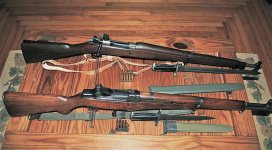Plain Old Dave
US Veteran
The Krag's bolt handle was meant as a safety backup in case the single lug cracked; it did not bear on the frame unless the single lug gave way. It also had a long longitudinal lug on the bolt which served the same purpose, so there were three lugs, only one of which actually bore on the frame under normal circumstances. The '03 had two load-bearing lugs and a rear safety lug which did not bear on the frame except in the event of an incredible overload that might crack the two forward lugs. Both rifles were designed with these safeguards, but the '03 had the strongest load-bearing lockup of the two. You are right in that the heat treatment of all of the Krags and the early '03s left something to be desired. The workers at Springfield had to eyeball the heat treatment; usually they were pretty good at it, but I'm sure there were "Monday rifles." The later '03 double heat treatment, and later, the nickel steel receivers and bolts took care of that problem.
John
I have seen a thread at doublegunshop where a gent milled the lug completely off of a Krag bolt and it held up fine. The Krag is IMO a needlessly-maligned military rifle and was used as a red herring by Elihu Root to mask systemic problems the US Army had in combined-arms tactics in the Spanish-American War; the only officer in Cuba with field experience above Company-level was Joe Wheeler. All the regular Generals were JOs in the Civil War and the US Army had not maneuvered infantry at above Regimental level anywhere but West Point (or even seriously thought about it) since 1865's Grand Review.
Denmark and Norway both fielded Krags in WW2, and reports indicate the Norwegian Krags were more capable arms than the German K98s. The Nazis would have to call in close air to eliminate Norwegian troops as they could not close even to mortar range due to rifle fire.


